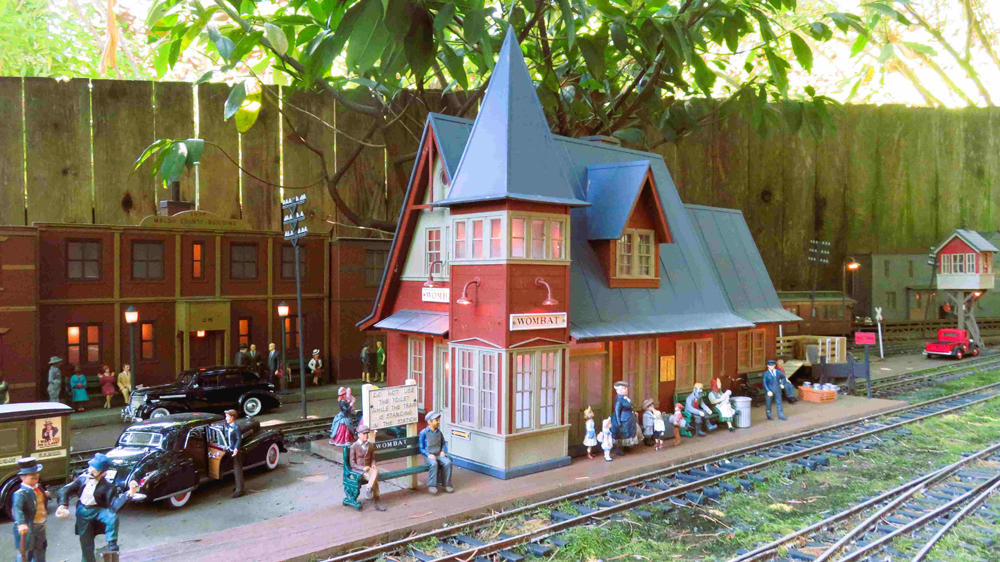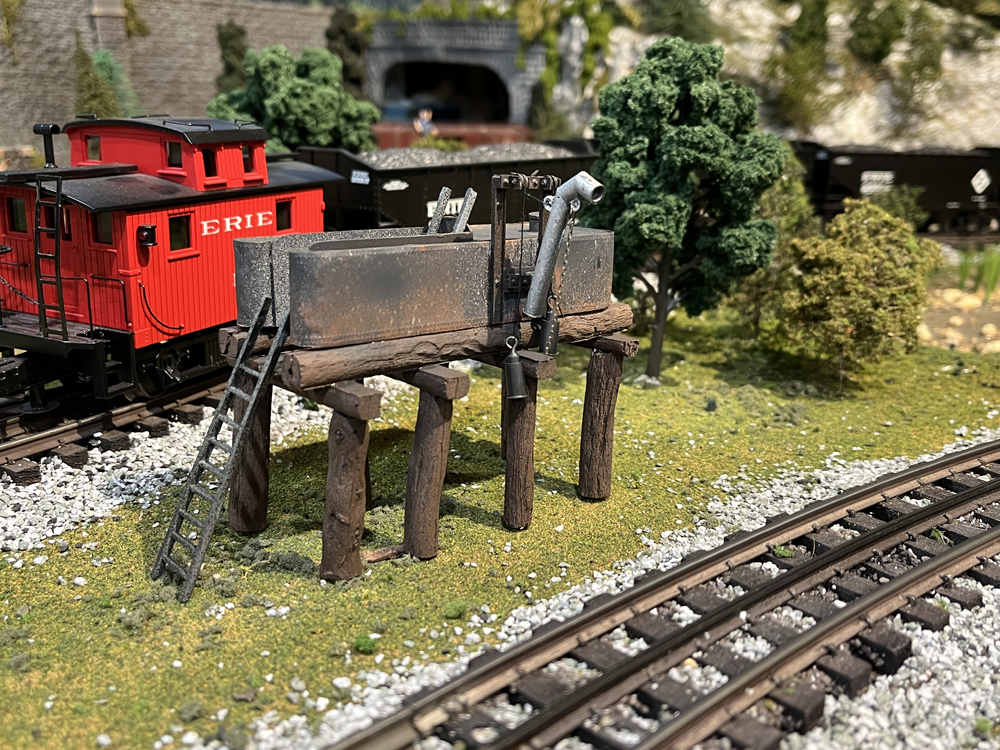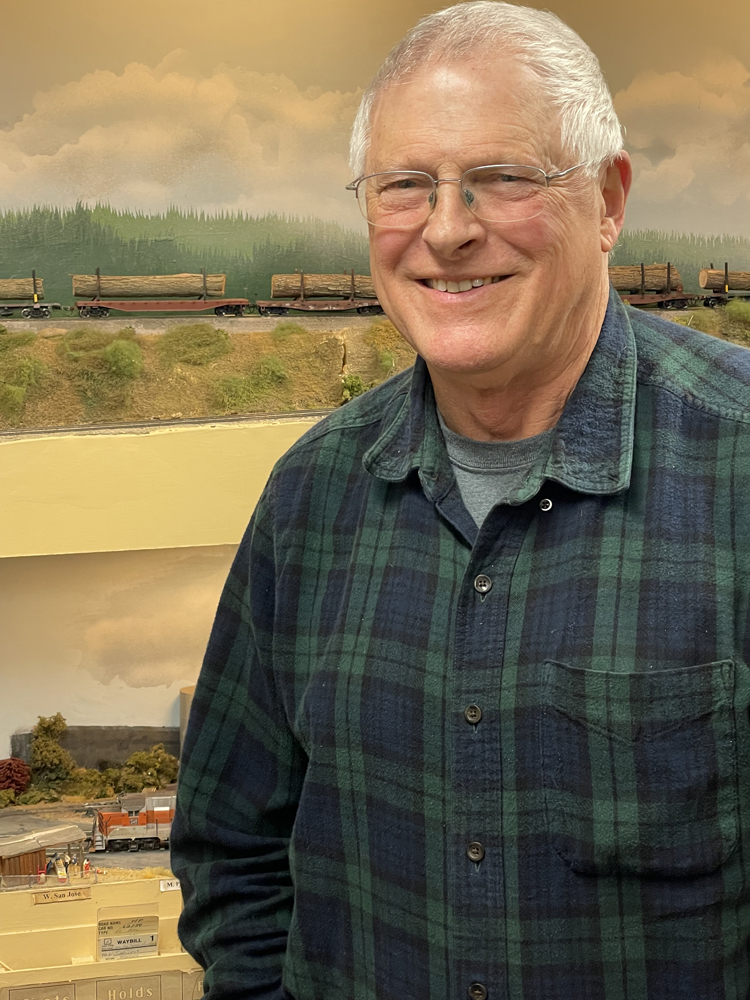Lionel’s skipper Jerry Calabrese also takes this philosophy to heart because he has introduced a product that’s sure to inspire lead-foot drivers behind the wheels of Chevy Monte Carlos nationwide. I’m talking about Lionel’s O gauge NASCAR train set.
Let’s look under the hood, or in this case the box cover, and see what Lionel has packed inside.
To begin, you get a boldly decorated GP38 diesel locomotive. It pulls a checkered boxcar containing a simulated NASCAR trophy, a flatcar carrying two NASCAR billboards, a single-dome tank car, and a caboose decorated with the graphics of three speed-blurred stock cars racing toward a finish line.
There’s also a conductor carrying a checkered flag that can be mounted on the rear platform of the caboose. Don’t forget the oval of FasTrack and a newly designed PowerMax transformer.
Keep in mind that this set promotes NASCAR, not any particular driver. If you’re looking for a certain driver, Lionel offers some expansion packs to satisfy driver loyalists.
The locomotive
The motive power in the NASCAR set is pretty much the same light diesel standard-bearer for starter sets that we’ve seen for years.
This Lionel GP38 is a generic sort of locomotive that could with little debate be dubbed a GP18, GP20, or GP40. We reviewed a very similar locomotive in our GP38 showdown in the November 1999 issue of CTT.
The locomotive has two small can-style motors without flywheels that are transversely mounted in the trucks.
The frame is made of sheet metal; the shell, truck side frames, and couplers are plastic. The handrails are stamped-metal extensions of the frame.
This GP38 has Lionel’s TrainSounds sound system with a horn, bell, diesel-motor sounds, and cab chatter. It’s an entry-level sound system not to be confused with Lionel’s RailSounds.
The model has a satisfactory level of detail as befits a toy train diesel. There aren’t any “wow” features, just a simple, elementary design.
The so-labeled dynamic brake blister rides atop the shell and pops off easily, so don’t grab it as a way of lifting the locomotive off the track, or you unintentionally may dump your train on the floor of your layout room.
The rolling stock
Like the locomotive, the rolling stock included in the NASCAR set is basic Lionel starter-set fare, the main difference being the graphics and NASCAR doodads. The cars, which were molded in colored plastic, are lightweight, and utilize plastic trucks and couplers.
The boxcar has a NASCAR checkered flag design that is among the best of the graphics in this set. Open either of the boxcar’s doors and you’ll find a miniature copy of a NASCAR trophy inside.
The flatcar carries two NASCAR promotional signs mounted in two traditional plastic billboards. You can run them on a flatcar after securing them with a “tie-down” rig, or you can place them at a strategic spot on your layout.
The tank car carries the Sunoco brand – probably one of the few corporate names from our childhood trains still seen on contemporary Lionel rolling stock.
The Sunoco logo is part of a wrap-around graphic adhered to the tank body that shows a wide-angle lens view of a NASCAR race with fans filling the grandstands. At a glance, however, it’s hard to figure out the image.
The caboose is small and features interior illumination and, as previously mentioned, a flag waver on the car’s rear deck. The circle-L herald on the cupola stands out nicely, but the images of stock cars crossing a finish line on the sides of the caboose are muddy and weakly defined.
There are two prongs on the rear platform of the caboose. Following the set’s instructions, you can raise the caboose roof slightly, depress the platform slightly, and slide the flag-waving conductor onto the prongs. Once the conductor is in place, he’s kept secure by the overhang of the roof.
On the test track
The GP38 was pretty darned anemic in the pulling department. After a greasing of the gears in our workshop, I got curious as to how much the GP38 could pull. So I hooked the locomotive up to the five freight cars from the Williams Girl’s Set as well as a new MTH VO-1000 dummy unit we have in our workshop.
Then I hit the juice using our workshop MTH Z-4000 transformer. I cranked the handle up to 17 and 18 volts, and the train slowly crept through one O54 curve on our oval test track, it began to speed up slightly, and then began once more to creep as it went back into the curve.
For comparison, we dug out a Lionel NJ Transit GP38 from 1998 and placed it on the front of the same train. At 12 volts it was like a rocket pulling the same consist; I didn’t bother to get it up to 18 volts because it would have flown off the test track.
Flipping the two locomotives on their backs, I noticed few differences between the two models in spite of their respective vintages. Both had trucks with traction tires and transverse-mounted motors. Both have sheet-metal frames. Though the NASCAR locomotive has a sound system, both locomotives registered 0.9 to 1.0 amps under way.
Rolling the axles, however, revealed that the 9-year-old NJ Transit locomotive had wheels and gears that spun freely, while the NASCAR engine’s gears were very tight.
We pulled other trains with the NASCAR diesel and came to the conclusion that this lightly powered locomotive was designed for a light weight starter set. It turns out that the five Williams cars weigh 4 pounds 5 ounces and the dummy MTH locomotive checks in at 3 pounds 4 ounces (total weight 7 pounds 9 ounces). This greatly surpassed the weight of all the NASCAR-set rolling stock – a mere 1 pound 13 ounces.
For the record, when I was running the NASCAR train on FasTrack and using the set’s own transformer, I found that the train had more pep. However, it was pulling a load just under 2 pounds.
When we placed the Williams rolling stock and the dummy MTH diesel on the oval of FasTrack with the GP38 on the point and the set transformer powering the rails, the GP38 couldn’t budge the train even at full throttle.
Our low-speed test average for the GP38 was 28.3 scale mph, while the high-speed average was 79.8 mph. I suspect that both speeds would improve with additional running to loosen up the gearing. Drawbar pull for the locomotive was 8 ounces.
Compare those statistics with to the performance of the Lionel NJ Transit model in our GP38 roundup from 1999. Then the numbers for our GP38 were a low of 40.2 scale mph and a NASCAR-like high of 179.6 scale mph. The drawbar pull topped out at 1 pound even. In short, the new version of the Geep has a more-appropriate speed range but an inferior drawbar pull.
The NASCAR locomotive has a basic diesel sound system that also includes automatic brake sounds, engine revs, and crew chatter when the horn is depressed.
Staff opinion was divided on TrainSounds, with the comments ranging from “pretty good” to “undefined.” For the most part, I thought that the sounds are similar to the electronic thrum of MTH’s LocoSound starter-set system, although the revs and braking sounds are authentic.
Using the Z-4000 transformer, the bell sound didn’t activate. When using the PowerMax transformer, the bell activated, but was so lost in the noise of the train-on-FasTrack (the track from the set box was sitting on a vinyl floor) that it was largely indistinguishable from the engine sounds.
When the locomotive is idling in neutral, hitting the horn button once triggers a railroad dialog series. I was half expecting to hear radio chatter between a NASCAR driver and the pit crew, the sort of stuff you would hear while watching a NASCAR race on TV.
To be honest, I wanted the NASCAR locomotive’s audio to be a throwback to the automotive sound-equipped hot rod Geeps that Lionel offered in the late 1990s. Those two flame-painted Geeps, with the sounds of revving V-8 engines, would have given NASCAR enthusiasts a laugh or two.
The GP38 has a directional lock-out switch and sound on/off switch on the fuel tank. While the instruction manual shows a volume-control knob next to the fuel tank, it is actually recessed into the frame above the rear truck. You’ll need a slot-head screwdriver to reach it.
The transformer is adequate for the set and for an add-on pack of three lightweight freight cars, but not much more. While the transformer case looks identical to Lionel’s CW-80, the PowerMax transformer offers just 30 watts instead of the CW-80’s 80 watts. The PowerMax offers less power than other O gauge train transformers on the market today.
Licensed train sets and add-on cars, from Looney Tunes to Harley Davidson, expose newcomers to our hobby. Lionel took the lead in this area with its popular Polar Express set. Less appealing, from the perspective of a hobbyist, is the NASCAR outfit, but it will accomplish the goal of getting train sets into homes that otherwise would not have one. And who can argue with that?
Price: $299.99 (no. 7-11004), six NASCAR expansion packs for $129 each
Features:O-27 operation (an oval of O-36 FasTrack track included); locomotive has two can-style motors, TrainSounds, headlights, and operating couplers; transformer
Pros: Popular theme, basic sound system, complete outfit with track and transformer, add-on packs designed specifically for this set
Cons: Quality of graphics inconsistent, tight drive train on our sample led to sluggish performance, all-plastic trucks and couplers, colored plastic instead of painted cars
Made in the People’s Republic of China for Lionel










I got my set for $99.00 too. and also got a Jimmie Johnson expansion pack for $30.00. At that price I'll display them if I ever take them out of the box.
Good article, I have also seen this set selling for a blow out price. Set collectors might jump at the price, but will wind up disappointed at the performance.
GREAT ARTICLE,GOT INTO INFO REAL DEEP,EVERYONE SHOULD BE WELL INFORMED. & THANKS.
I bought my NASCAR set two years ago for $99.00, I am comletely
satisfied, don't know how they sold them for this price.
I bought mine for $99.00 and I am completely satisfied with
the set. I don't know how they sold them for this price, I
bought mine two years ago for this price $99.00.
Hi, I am seeing this product everywhere for 99 dollars. Anyone know what is going on. Is there some flaw that has come out or something. I was about to buy it earlier this year for 269. Now at 99 instead of jumping on it I am weary. Any suggestions welcome.
I got a deal on one and decided to grab it just for play purposes. The engine has no real pulling power, but I have yet to run it more to see if that will free it up. It is a mediocre set, but if you like NASCAR like my 10 year old son, then it is worth it in play value alone.